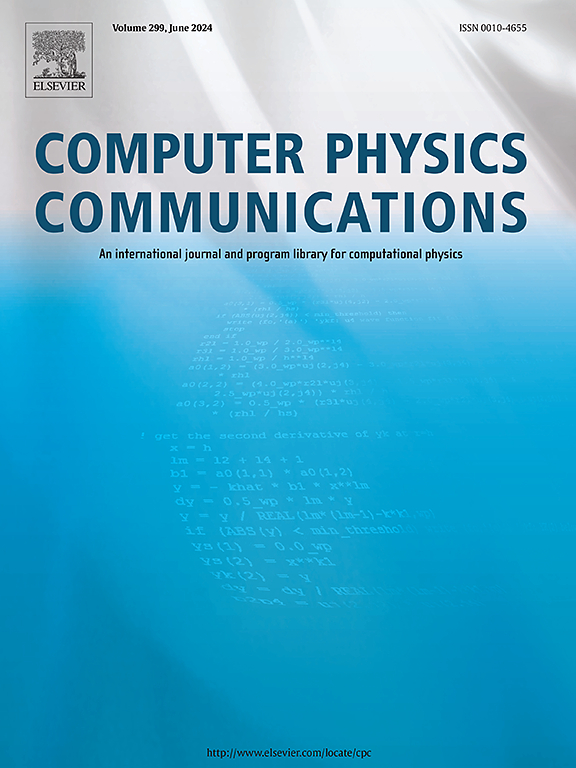一个基于神经网络的Python包,用于使用pCI和其他高性能原子代码执行大规模原子CI
IF 7.2
2区 物理与天体物理
Q1 COMPUTER SCIENCE, INTERDISCIPLINARY APPLICATIONS
引用次数: 0
摘要
现代原子物理学在科学技术中的应用,对原子和离子性质计算的精度提出了越来越高的要求。特别具有挑战性的是在配置相互作用(CI)框架内对电子相关性进行建模,这通常需要在Slater决定因素或配置状态函数的巨大基础中展开原子状态。即使对于运行在分布式超级计算机系统上的高效原子代码,这也很容易使问题变得棘手。最近,我们使用神经网络(NN)方法[1]成功地解决了这个问题。在这项工作中,我们展示了使用pCI[2]和其他高性能原子代码执行nn支持的大规模原子CI的Python代码。程序摘要程序标题:nn_for_pciCPC库链接到程序文件:https://doi.org/10.17632/yy29nhwkbw.1Developer's存储库链接:https://github.com/pavlobilous/nn_for_pciLicensing条款:gplv3编程语言:python问题的性质:原子CI方法中基大小的指数缩放解决方法:基于迭代神经网络的相关基元素选择出一个大的CI基础参考[1]P。Bilous, C. b张,M. Safronova, Phys。Rev. A 110(2024) 042818。M.G. Kozlov, S.G. Porsev, M.S. Safronova, I.I. Tupitsyn, A.I. Bondarev, Comput。理论物理。common . 308(2025) 109463。本文章由计算机程序翻译,如有差异,请以英文原文为准。
A neural-network-based Python package for performing large-scale atomic CI using pCI and other high-performance atomic codes
Modern atomic physics applications in science and technology pose ever higher demands on the precision of computations of properties of atoms and ions. Especially challenging is the modeling of electronic correlations within the configuration interaction (CI) framework, which often requires expansions of the atomic state in huge bases of Slater determinants or configuration state functions. This can easily render the problem intractable even for highly efficient atomic codes running on distributed supercomputer systems. Recently, we have successfully addressed this problem using a neural-network (NN) approach [1]. In this work, we present our Python code for performing NN-supported large-scale atomic CI using pCI [2] and other high-performance atomic codes.
Program summary
Program Title: nn_for_pci
CPC Library link to program files: https://doi.org/10.17632/yy29nhwkbw.1
Developer's repository link: https://github.com/pavlobilous/nn_for_pci
Licensing provisions: GPLv3
Programming language: Python
Nature of problem: Exponential scaling of the basis size in the atomic CI approach
Solution method: Iterative NN-based selection of the relevant basis elements out of a large CI basis
References
- [1]P. Bilous, C. Cheung, M. Safronova, Phys. Rev. A 110 (2024) 042818.
- [2]C. Cheung, M.G. Kozlov, S.G. Porsev, M.S. Safronova, I.I. Tupitsyn, A.I. Bondarev, Comput. Phys. Commun. 308 (2025) 109463.
求助全文
通过发布文献求助,成功后即可免费获取论文全文。
去求助
来源期刊

Computer Physics Communications
物理-计算机:跨学科应用
CiteScore
12.10
自引率
3.20%
发文量
287
审稿时长
5.3 months
期刊介绍:
The focus of CPC is on contemporary computational methods and techniques and their implementation, the effectiveness of which will normally be evidenced by the author(s) within the context of a substantive problem in physics. Within this setting CPC publishes two types of paper.
Computer Programs in Physics (CPiP)
These papers describe significant computer programs to be archived in the CPC Program Library which is held in the Mendeley Data repository. The submitted software must be covered by an approved open source licence. Papers and associated computer programs that address a problem of contemporary interest in physics that cannot be solved by current software are particularly encouraged.
Computational Physics Papers (CP)
These are research papers in, but are not limited to, the following themes across computational physics and related disciplines.
mathematical and numerical methods and algorithms;
computational models including those associated with the design, control and analysis of experiments; and
algebraic computation.
Each will normally include software implementation and performance details. The software implementation should, ideally, be available via GitHub, Zenodo or an institutional repository.In addition, research papers on the impact of advanced computer architecture and special purpose computers on computing in the physical sciences and software topics related to, and of importance in, the physical sciences may be considered.
 求助内容:
求助内容: 应助结果提醒方式:
应助结果提醒方式:


